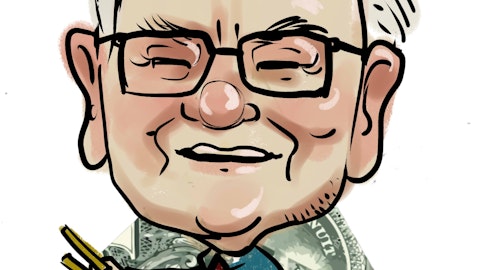I’ve watched PepsiCo, Inc. (NYSE:PEP) for years, and several times the stock looked like a good value and I almost bought shares. However, for all the positives that I could find, there always seemed to be an issue under the surface. Unfortunately that is the case again with PepsiCo’s recent earnings. There are at least four big worries that I see, but I haven’t heard anyone else bring them up.

Everyone knows that the beverage industry is dominated by PepsiCo and their nemesis The Coca-Cola Company (NYSE:KO). It seems that over the years, PepsiCo, Inc. (NYSE:PEP) management made choices that kept PepsiCo, Inc. (NYSE:PEP) from being the best investment in this industry. Whether it was the old investment in what is now Yum! Brands, Inc. (NYSE: YUM), or the choice to keep Frito-Lay and Pepsi beverages as one company, there seems to always be something standing in the company’s way.
Unless management makes the decision to split their beverage operations from their food divisions, we will never get a perfect comparison to The Coca-Cola Company (NYSE:KO). However, this is the bed that PepsiCo, Inc. (NYSE:PEP) has made, and they have to lie in it.
This Looks Like A Very Good Quarter…Doesn’t It?
At first, I was impressed by PepsiCo’s current quarter results. The company reported EPS up 19%, they increased the dividend by 5.6%, and multiple divisions saw volume growth of 3% or more. Growth markets like Asia, the Middle-East, and Africa showed “double-digit” volume growth in snacks, and “mid-single digit” volume growth in beverages. Investors should be happy, right?
However, this wasn’t as good of a quarter as it appeared. Several divisions saw volume growth, but the company’s overall revenue was down 1% year-over-year. One of the issues was the Pepsi Americas Beverages division. In this division, carbonated beverage volume was flat, while non-carbonated beverage volume increased by “low single-digits.”
Relative to their peers, these results underperformed the industry. For instance, The Coca-Cola Company (NYSE:KO) saw carbonated beverage volumes up 1%, and non-carbonated beverage volumes were up 9%. The category leader was Monster Beverage Corp (NASDAQ:MNST), which last reported an 18% increase in case volume. Dr Pepper Snapple Group Inc. (NYSE:DPS). did better in carbonated beverages with a 1% volume increase. However, the company did lag PepsiCo and the industry with a 5% decrease in non-carbonated beverages.
3 Issues Rolled Into One
Actually three of PepsiCo’s main issues are tied together in a neat little ball of problems. One challenge the company faces is, their operating margin is significantly lower than their peers. In the last three months, PepsiCo’s margin was just 11.09%. By comparison, Coca-Cola reported an operating margin of 19.06%, Dr. Pepper Snapple managed 19.68%, and Monster Beverage again led the way with a margin of 26%.
This lower operating margin is partially because PepsiCo, Inc. (NYSE:PEP) operates in both the beverage and snacks business. However, the bigger issue was a problem in the company’s Asia, Middle-East, and Africa division. In a strange turn of events, the company reported strong snack and beverage volume growth, but revenue was down 13% and operating profit decreased 25%. None of PepsiCo’s competition reported issues like this in their overseas operations.
The really big problem for investors is, these problems led to earnings that were down, if you know how to read the financials. PepsiCo reported EPS increased by 19%. However, all of this increase was due to a 49% lower tax provision in the quarter. With a similar tax provision to last year, EPS actually decreased 1.12%. With The Coca-Cola Company (NYSE:KO) reporting a 15% EPS gain, a 5% increase at Dr. Pepper Snapple, and a 6.1% increase at Monster Beverage, you can see PepsiCo’s real results are less than encouraging.
Questionable Guidance
Reading PepsiCo’s guidance for the year was a bit like deciphering a secret message with a decoder ring. When a company uses words like “core constant currency” to describe its EPS guidance I begin to get nervous. If you read between the lines of what the company said, you’ll know why.
In 2012, PepsiCo returned $6.5 billion to shareholders through share repurchases and dividends. Assuming all things being equal, investors might expect slightly more in 2013 because of the 5.6% dividend increase. However, the company said they expected to return $6.4 billion. This doesn’t sound like much of a difference, but with a 5.6% higher dividend, share repurchases will have to be curtailed.
In addition, PepsiCo, Inc. (NYSE:PEP) said they expect, “higher interest expense driven by increased debt balances.” In plain English, the company is going to borrow money to return the aforementioned $6.4 billion to shareholders. Since PepsiCo’s debt-to-equity ratio is already 1.05, this means the ratio will trend higher next year. This wouldn’t be a bad thing, except Dr. Pepper Snapple is the only peer with a higher ratio at 1.12. Compared to Coca-Cola’s debt-to-equity ratio of 0.44 and Monster’s debt free balance sheet, this puts PepsiCo in an even more difficult competitive position.
The bottom line is, PepsiCo turned in a quarter with major problems in Asia, the Middle-East, and Africa. The company also had the lowest margin of their peers, and without lower taxes their EPS would have decreased. Given that they are planning on borrowing money to pay dividends and repurchase shares, their second weakest balance sheet is going to get worse. Some things never change, I want to like the company, but there are too many unresolved problems. Given the alternatives, investors should look at PepsiCo’s recent price increase as a profit taking opportunity.
The article 4 Worries No One’s Talking About originally appeared on Fool.com and is written by Chad Henage.
Copyright © 1995 – 2013 The Motley Fool, LLC. All rights reserved. The Motley Fool has a disclosure policy.




